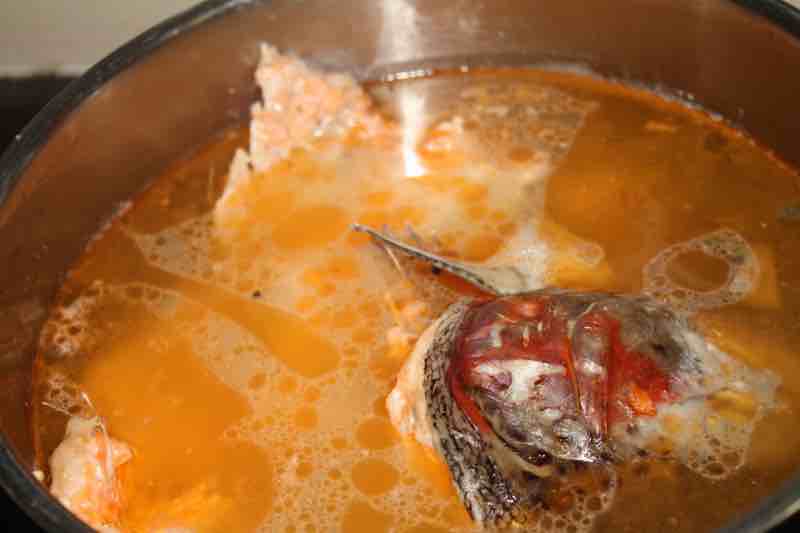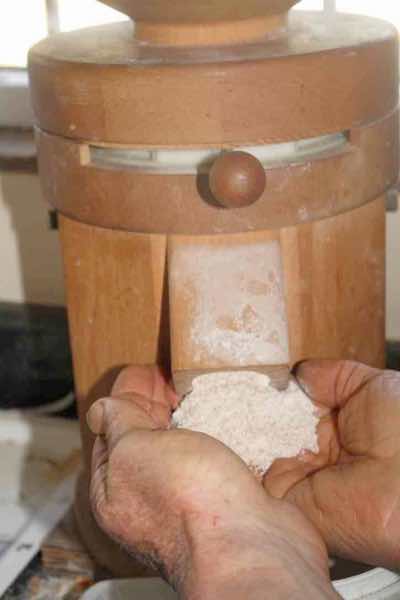- Bernard Preston homepage
- Easy Soup
- How to Make Fish Stock
How to make fish stock
How to make fish stock really does not require higher mathematics. You want to extract most of the nutrients and especially the fat which is rich in omega-3; and the wonderful gelatine for our bones. We use here the skeleton and head of a deep water Norwegian salmon.
We use various vegetables and spices to improve the nutritional content and flavour. Lurking behind all our recipes are ways to increase the number of coloured-foods in our cooking.

- One or more fish-skeletons, including the head and tail
- Half an onion
- Half a dozen celery-stalks including the leaves if fresh
- 1 chopped-carrot
- 1/2 tsp peppercorns
- A small chunk of peeled and grated ginger
- A thyme frond
- Lightly fry the onion, celery and carrot in a small dab of butter; add the ginger and peppercorns.
- Add the fish skeleton and head; continue to saute on very low heat with the lid on for about 15-minutes.
- Cover with boiling water and simmer for another fifteen-minutes, or so; until tender.
- Allow to steep for half an hour and then strain before it cools; or the gelatine will solidify.
- Freeze in cup-size containers. Squeeze the blocks out and store in zip lock bags.
How to make fish stock
How to make fish stock is a very inexpensive way to get huge amounts of omega-3 fatty acids which make up forty percent of the brain.
Waste not, want not goes the old saying. I first learned many years ago how to make fish stock after visiting the market in Rotterdam. I was shocked how the bones and heads were simply discarded; I could purchase a whole wild North-Atlantic salmon skeleton for a euro.
There was a lot of meat left on the bones and in the head after it has been filleted; good food that is given to those nasty, cheeky seagulls. I have no time for them.
So along with our herring, smoked mackerel and eel we would always bring home a salmon carcass from the Rotterdam fish-market.
Omega-3 in fish stock
Soon we learned how to improve the flavour of our food with a fish
stock. Just the omega-3 oil in that salmon made it worthwhile; there is
such an abundance of research now how important the DHA and EPA fatty acids are. Not that ALA from plants is less so.
Nearly half the brain is made up of omega-3 fats; and even more in the retina of the eye.
The third common omega-3 fatty acid is known as ALA. It comes from vegetables sources like your greens and chickpeas; and seeds like flax.
Those who know how to make fish stock, enjoy hummus made with chickpeas and love their greens will get plenty of omega-3. You really don't need to spend a lot of money on expensive supplements that may be contaminated with mercury.
"Let thy food be thy medicine, and medicine be thy food."
Hippocrates (460 - 370 BC)
Blood vessels
There is massive amount of research confirming that omega 3 is not only important for the brain and eyes but also for the lining of our blood vessels[1]; and our joints. Virtually every tissue in the body needs these important anti-inflammatory fats.
Vegetarians can get enough if they will enjoy freshly-ground flaxseed[3] with their food; oddly it has a slightly fishy smell. The best sources of DHA and EPA come from the sea though.
The exception is purslane plant which contains all three of the omega-3 fatty acids.
Fat is not the great enemy; it's refined-carbohydrate that makes us obese and raises the spectre of diabetes.
It is only since Americans were advised to reduce the fat in their diet and make carbohydrate the source of more than half of their calories that they have become morbidly obese.
If you have the time watch the absorbing film Fat Fiction[2] as the scientists lay out how lipids were bedevilled by the food industry.
Deep sea cold water fish and freshly ground flaxseed are included in our 10 top anti-inflammatory foods.
Omega-3 in seeds
All seeds but particularly flax and wheat are rich in alpha linolenic acid, the plant source of omega-3.
Research proves that those consuming foods rich in ALA are far less likely to suffer from heart failure.
True wholegrain bread
True 100% wholegrain wheat bread is almost impossible to buy. The flour is also rich in alpha-linolenic acid, one of the three important omega 3 FAs; you need your own mill.
Strong research[4] proves that the wheat germ oil (which is extracted from all grocery store bread) has a powerful anti-inflammatory action by reducing oxidative stress. It contains 13.6 times more ALA than does corn oil.
The vitamin E probably also plays a role, reducing platelets and acting as nature's own true anti-coagulant. Prior to the milling and refining of flour, heart attacks were almost unknown.

Join the real bread movement; bake your own.
Fish soup and true wholegrain bread
Real protection against heart disease contained by simple meal of fish soup and true wholegrain bread; it contains all three of the omega-3 fatty acids.
When browsing use right click and "Open Link in New Tab" or you may get a bad gateway signal.
Newsletter
Our newsletter is entitled "create a cyan zone" at your home, preserving both yourself and Mother Earth for future generations; and the family too, of course. We promise not to spam you with daily emails promoting various products. You may get an occasional nudge to buy one of my books.
Here are the back issues.
- Lifestyle and ideal body weight
- What are ultra-processed foods?
- Investing in long-term health
- Diseases from plastic exposure
- Intensive lifestyle management for obesity has limited value
- A world largely devoid of Parkinson's Disease
- The impact of friendly bacteria in the tum on the prevention of cancer
- There's a hole in the bucket
- Everyone is talking about weight loss drugs
- Pull the sweet tooth
- If you suffer from heartburn plant a susu
- Refined maize meal and stunting
- Should agriculture and industry get priority for water and electricity?
- Nature is calling
- Mill your own flour
- Bake your own sourdough bread
- Microplastics from our water
- Alternative types of water storage
- Wear your clothes out
- Comfort foods
- Create a bee-friendly environment
- Go to bed slightly hungry
- Keep bees
- Blue zone folk are religious
- Reduce plastic waste
- Family is important
- What can go in compost?
- Grow broad beans for longevity
- Harvest and store sunshine
- Blue zone exercise
- Harvest and store your rainwater
- Create a cyan zone at your home
Did you find this page interesting? How about forwarding it to a friendly book or food junkie? Better still, a social media tick would help.
- Bernard Preston homepage
- Easy Soup
- How to Make Fish Stock
Address:
56 Groenekloof Rd,
Hilton, KZN
South Africa
Website:
https://www.bernard-preston.com